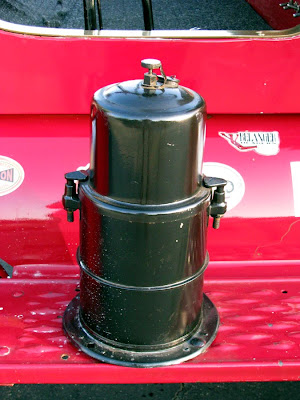 No doors and no seatbelts; no front brakes, air bags, shoulder strap, safety glass windshield, roll over crush cage roof thingy to keep you from being squished under the car, no bumpers, no safety equipment of any kind.
No doors and no seatbelts; no front brakes, air bags, shoulder strap, safety glass windshield, roll over crush cage roof thingy to keep you from being squished under the car, no bumpers, no safety equipment of any kind.And its one of the most fun cars you can drive legally on American roads. Because its all Ford, even though it's the best of the Model T and Model A parts, and built in a garage instead of the Ford factory.
 Between the I beam and the radiator, above the leaf springs, are Hassler springs that reduce side to side sway and lean.
Between the I beam and the radiator, above the leaf springs, are Hassler springs that reduce side to side sway and lean.
 The above canister is a Carbonate powder gas generator that would have been supplying gas for the headlights, well before headlights evolved into electric illumination.
The above canister is a Carbonate powder gas generator that would have been supplying gas for the headlights, well before headlights evolved into electric illumination. The silver canister above is the muffler
The silver canister above is the muffler These two photos show the adapters for Model A rims, because they are wider and safer... the above is just an adapter, the below also has the gear set for the original speedometer
These two photos show the adapters for Model A rims, because they are wider and safer... the above is just an adapter, the below also has the gear set for the original speedometer
 The back area is also used for a pickup bed that bolts on.
The back area is also used for a pickup bed that bolts on. The innovations that Henry Ford brought to making cars are historically and presently important, and were simple genius in action. Deciding to make cars for the vast majority of people in America was key to Ford's success, instead of the 1600 or so other car makers in America that didn't last past the great depression http://justacarguy.blogspot.com/2007/07/prior-to-great-depression-there-were.html most of them weren't capable of producing enough, to profit heavily enough, to survive the loss of customers, however most that disappeared were catering to a small customer base that was looking for luxurious cars that stood out and were impressive everywhere the owner was chauffeured.
The innovations that Henry Ford brought to making cars are historically and presently important, and were simple genius in action. Deciding to make cars for the vast majority of people in America was key to Ford's success, instead of the 1600 or so other car makers in America that didn't last past the great depression http://justacarguy.blogspot.com/2007/07/prior-to-great-depression-there-were.html most of them weren't capable of producing enough, to profit heavily enough, to survive the loss of customers, however most that disappeared were catering to a small customer base that was looking for luxurious cars that stood out and were impressive everywhere the owner was chauffeured. 
I just learned that the floorboards were one of the innovative money savers, the floorboards had started as hand formed and carefully made to fit due to the large differences in the early handmade cars that mastercraftsmen put together, but when the production shifted to assembly line unskilled laborers, and the tolerances of fitment became smaller, there was less time to get custom shaped pieces in place... so Ford had the transmission crates that were delivering transmissions to the assembly line made to specific dimensions that would be perfect to use as floorboards for the car! Brilliant! No longer disposing of the crates, or wasting them by reusing them to move more transmissions, they made a one way trip, just like the transmissions, and labor was saved from moving them back to repack more trans in.
When the early cars had wood for the frames, panels, doors, and most everything else, the craftsmen produced as a byproduct of their custom work, a lot of cast off trim pieces, odd bits that were cut off and not useful for any other car related item. Thomas Edison and Henry Ford noticed this waste, and realized that waste wasn't profit, so they invented charcoal, and used that to make profits too! How inventive and clever is that! Finding a use for the waste and the cast off byproducts of your factory to make more products, and more profit. Genius.